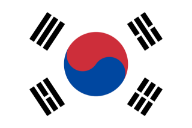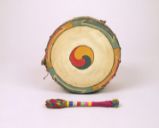Colorful symbolism
The Yonggo has a striking appearance due to the portrayal of a dragon painted on the body. The dragon is an important symbol in Korea both through myths as well as through Buddhism. In this case, it symbolizes imperial power.
Often, one can see a three-colored circle in the centre of the head of the Janggu. This symbol is called the tricolored Taegŭk and is a variant on the symbol represented in the national flag of South Korea. Red represents positive cosmic forces whereas blue represents the opposing negative ones, thereby forming harmony. Yellow is added in order to represent humanity. This symbol originally derived from Tibetan and East Asian Buddhism.
Just like the many colorful temples in Korea, the Puk that are used in court also have a variety of five basic colors:
White represents metal and the west. Black represents water and the north. As for blue, Koreans used to view blue and green as variations of the same color, so this represented both trees as well as clouds, rain and the east. Red represents the south and fire. Last but not least, yellow represents earth and the center.


